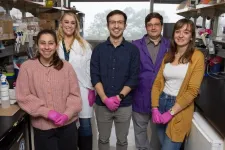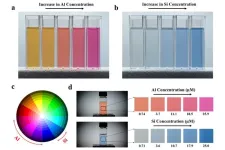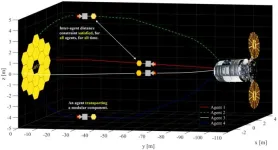(Press-News.org) In late July to October 2022, residents of the Manu’a Islands in American Samoa felt the earth shake several times a day, raising concerns of an imminent volcanic eruption or tsunami.
An earthquake catalog for the area turned up nothing, because the islands lacked a seismic monitoring network that could measure the shaking and aid seismologists in their search for the source of the earthquake swarm.
But the residents of the Taʻū, Ofu, and Olosega islands needed answers, so Clara Yoon of the U.S. Geological Survey and her colleagues found another way to fill in the seismic blanks. They used machine learning and another technique called template matching on shaking data recorded from a single seismic sensor located 250 kilometers away from the American Samoa swarm.
In The Seismic Record, Yoon and colleagues share how they tracked the swarm using these single-station data, combined with shaking reports from residents, until local permanent seismic stations were installed in American Samoa in August and September 2022.
The non-eruptive volcanic earthquake swarm began in July 2022 about 15 kilometers offshore of Taʻū Island. The Samoa volcanic islands arise as the Pacific tectonic plate moves over a hotspot in the south Pacific Ocean.
Resident reports of the frequent shaking, occurring multiple times a day for a few seconds at a time, were the only information about the swarm at first.
“When the earthquakes started, American Samoa had no instrumental geophysical monitoring, so even basic information about the source of the shaking–with implications for emergency decision-making and public safety–was nonexistent,” said Yoon.
To remedy this, the researchers turned to a remote seismic station on Upolu, Samoa, part of the Global Seismographic Network, that has data that can be downloaded in near-real time through the EarthScope data center, Yoon noted.
The seismic signal of the American Samoa earthquake swarm was difficult to detect at the distant station, however, so Yoon and colleagues used a deep-learning model called EQTransformer, along with a technique called template matching, to pick these tiny earthquakes out of a noisy seismic background.
“EQTransformer found many earthquakes with locations consistent with eastern American Samoa, the largest of which matched up with times of felt reports,” Yoon explained. “These felt reports, contributed by local residents of American Samoa to the National Weather Service, were essential sources of data about the earthquakes, and gave us confidence that the EQTransformer-detected events were actually the same earthquakes felt by the local population.”
With this new earthquake catalog for the event, the researchers were able to characterize the onset and the peak of the swarm activity. Portable and inexpensive Raspberry Shake sensors deployed in August 2022 helped to quickly locate the area of the swarm.
The swarm ended in October 2022 without an eruption, but was likely related to volcanic magma movement, the researchers concluded.
Yoon noted that an approach like their single-station technique could be useful in other places around the world where permanent seismic monitoring is sparse and seismic hazard is poorly understood, such as offshore regions with tsunami potential or earthquakes within a tectonic plate.
She added that the largest earthquake in the American Samoa swarm was magnitude 4.5, making it unlikely that it would have been detected by global seismic networks.
“If no one had lived nearby to report the frequent shaking, this American Samoa swarm may have gone entirely unnoticed,” Yoon said. “Many unknown seismic sources and phenomena are waiting to be discovered, perhaps by future large-scale comprehensive applications of deep-learning approaches in seismology.”
END
Scientists use distant sensor to monitor American Samoa earthquake swarm
2025-02-14
ELSE PRESS RELEASES FROM THIS DATE:
New study explains how antidepressants can protect against infections and sepsis
2025-02-14
LA JOLLA (February 14, 2025)—Antidepressants like Prozac are commonly prescribed to treat mental health disorders, but new research suggests they could also protect against serious infections and life-threatening sepsis. Scientists at the Salk Institute have now uncovered how the drugs are able to regulate the immune system and defend against infectious disease—insights that could lead to a new generation of life-saving treatments and enhance global preparedness for future pandemics.
The Salk study follows recent findings that users of selective ...
Research reveals how Earth got its ice caps
2025-02-14
University of Leeds news
Embargoed until 14 February 2025 (19:00 GMT)
---
The cool conditions which have allowed ice caps to form on Earth are rare events in the planet’s history and require many complex processes working at once, according to new research.
A team of scientists led by the University of Leeds investigated why Earth has existed in what is known as a 'greenhouse' state without ice caps for much of its history, and why the conditions we are living in now are so rare.
They found ...
Does planetary evolution favor human-like life? Study ups odds we’re not alone
2025-02-14
UNIVERSITY PARK, Pa. — Humanity may not be extraordinary but rather the natural evolutionary outcome for our planet and likely others, according to a new model for how intelligent life developed on Earth.
The model, which upends the decades-old “hard steps” theory that intelligent life was an incredibly improbable event, suggests that maybe it wasn't all that hard or improbable. A team of researchers at Penn State, who led the work, said the new interpretation of humanity’s origin increases the probability ...
Clearing the way for faster and more cost-effective separations
2025-02-14
CLEVELAND—The process of separating useful molecules from mixtures of other substances accounts for 15% of the nation’s energy, emits 100 million tons of carbon dioxide and costs $4 billion annually.
Commercial manufacturers produce columns of porous materials to separate potential new drugs developed by the pharmaceutical industry, for example, and also for energy and chemical production, environmental science and making foods and beverages.
But in a new study, researchers at Case Western Reserve University have found these ...
Researchers develop a five-minute quality test for sustainable cement industry materials
2025-02-14
CHAMPAIGN, Ill. — A new test developed at the University of Illinois Urbana-Champaign can predict the performance of a new type of cementitious construction material in five minutes — a significant improvement over the current industry standard method, which takes seven or more days to complete. This development is poised to advance the use of next-generation resources called supplementary cementitious materials — or SCMs — by speeding up the quality-check process before leaving the production floor.
Due ...
Three Texas A&M professors elected to National Academy Of Engineering
2025-02-14
Drs. Vanderlei Bagnato, Rodney Bowersox and Don Lipkin from Texas A&M University’s College of Engineering have been elected to the National Academy of Engineering (NAE) Class of 2025, joining 128 new members and 22 international members. This is one of the highest professional honors for engineers.
“Congratulations to Drs. Bagnato, Bowersox and Lipkin for achieving this recognition. This prestigious honor reflects their groundbreaking contributions to engineering and underscores the exceptional talent within our faculty,” said Dr. Robert H. Bishop, vice chancellor and dean of Texas A&M ...
New research sheds light on using multiple CubeSats for in-space servicing and repair missions
2025-02-14
As more satellites, telescopes, and other spacecraft are built to be repairable, it will take reliable trajectories for service spacecraft to reach them safely. Researchers in the Department of Aerospace Engineering in The Grainger College of Engineering, University of Illinois Urbana-Champaign are developing a methodology that will allow multiple CubeSats to act as servicing agents to assemble or repair a space telescope. Their method minimizes fuel consumption, guarantees that servicing agents never come closer to each other ...
Research suggests comprehensive CT scans may help identify atherosclerosis among lung cancer patients
2025-02-14
Several cardiovascular risk factors, such as advanced age and smoking history, are prevalent among lung cancer patients at the time of the diagnosis and increase their risk of future heart disease, according to a new study being presented at ACC’s Advancing the Cardiovascular Care of the Oncology Patient course. Comprehensive assessments are needed in this vulnerable group to improve survival outcomes and quality of care for cancer patients.
Heart disease and cancer are the leading causes of death in the United States. Smoking is a shared risk factor for lung cancer and cardiovascular disease, and lung cancer patients have an amplified mortality rate with the presence of ...
Adults don’t trust health care to use AI responsibly and without harm
2025-02-14
A study finds that 65.8% of adults surveyed had low trust in their health care system to use artificial intelligence responsibly and 57.7% had low trust in their health care systems to make sure an AI tool would not harm them.
The research letter was published in JAMA Network Open.
Adults who had higher levels of overall trust in their health care systems were more likely to believe their providers would protect them from AI-related harm.
The letter, authored by Jodyn Platt, Ph.D., of the Department of Learning Health Sciences at University of Michigan Medical School and Paige Nong, Ph.D., of the University of Minnesota School of Public Health comes from survey of a nationally ...
INSEAD webinar on the dual race to AI & global leadership
2025-02-14
Digital@INSEAD is hosting a free TECH TALK X webinar “The Dual Race to AI & Global Leadership” on Wednesday, 19 February 2025 7.00 am ET / 1.00 pm CET (Duration: 60 min).
The TECH TALK will be featuring a discussion between Tim Gordon (MBA’00D), Partner, Best Practice AI and Theos Evgeniou, INSEAD Professor of Technology & Business and Director of Executive Programs in AI.
Tim, an INSEAD alumnus with over 20 years of international experience in digital transformation, global strategy and innovation, will join Theos to explore the two critical AI races reshaping our world: ...





